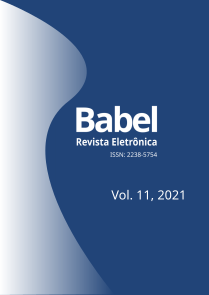Surface and depth: Iconic flows in Conrad Ferdinand Meyer’s poetry
DOI:
https://doi.org/10.69969/revistababel.v11i.10347Keywords:
Conrad Ferdinand Meyer, Im Spätbot, Auf dem Canale Grande, ImagesAbstract
Conrad Ferdinand Meyer lived between 1825 and 1898, in Zurich, Switzerland. Along with Gottfried Keller and Jeremias Gotthelf, he is one of the most important voices in 19th century Swiss literature. With a wide literary production, the author wrote novels, novellas and poems. This article focuses on his poetic work, analyzing two poems in which images stand out as a fundamental principle in the organization of their flow of meaning. Images represent a way of mediating, but also of apprehending reality, building with words an inseparable pair in epistemological practice. In this context, the concept of iconic consciousness seeks to explain how images have an impact on the formation of other forms of knowledge, besides linguistic representation. Conrad Ferdinand Meyer's poetry reveals a similar desire by thinking about how images have their own dynamics in the poetic text. Thus, with a focus on the flows between surface and depth, this article wishes to discuss the poems "Im Spätbot" and "Auf dem Canale Grande", in order to analyze the relationship between images and words as iconic flows, in these poems. The discussion of the two poems aims to verify how visual and verbal representations come together, in order to reveal dimensions of meaning that remain in a flow between surface and depth.
Downloads
References
ALEXANDER. Jeffrey C. Iconic consciousness: the material feeling of meaning. Environment and Planning D: Society and Space, v. 26, 2008, p. 782-794. Disponível em: https://journals.sagepub.com/doi/10.1177/0725513610381369.
BARTMANSKY, Dominik. The word/image dualism revisited: Towards an iconic conception of visual culture. Journal of Sociology, 2014, v. 50, n. 2, p. 164-181. Disponível em: https://journals.sagepub.com/doi/abs/10.1177/1440783312444804.
GROYS, Boris. The Border between Word and Image. Theory, Culture & Society, v. 28, nr. 2, 2011, p. 94-108. Disponível em: https://journals.sagepub.com/doi/abs/10.1177/0263276410396911.
JAY, Martin. Downcast Eyes: The Denigration of Vision in Twentieth-century French Thought. Berkeley: University of California Press, 1994.
MACHADO DE OLIVEIRA JR, Wenceslao. Grafar o espaço, educar os olhos. Rumo a geografias menores. Pro-Posições, v. 20, n. 3 (60), 2009, p. 17-28. Disponível em: https://periodicos.sbu.unicamp.br/ojs/index.php/proposic/article/view/8643385.
MEYER, Conrad Ferdinand. Vinte poemas em tradução literal. Tradução de Dionei Mathias. Em Tese, v. 23, nr. 2, 2017, p. 174-192. Disponível em: http://www.periodicos.letras.ufmg.br/index.php/emtese/article/view/12468.
SORG, Bernhard. Geschichte der deutschen Lyrik. Band 4: Zwischen Romantik und Naturalismus. Stuttgart: Reclam, 2012.
Published
How to Cite
Issue
Section
License
Os autores detém os direitos autorais sem restrições, porém ao submeter os originais, concordam em transferir a este periódico os direitos da primeira publicação. Isto deve ser informado em caso de nova edição do texto. As produções que derivarem deste material, devem obrigatoriamente citar a fonte. Os textos publicados nesta revista, salvo indicações contrárias, encontram-se sob uma licença Creative Commons Atribuição 4.0 Internacional.

